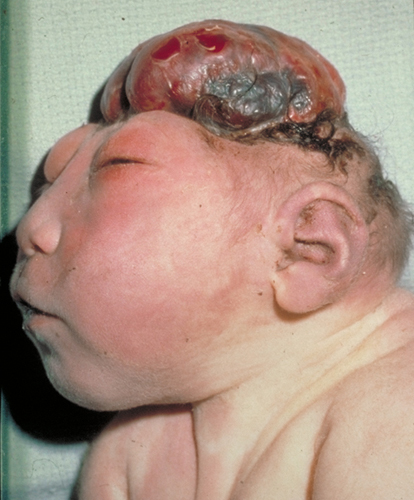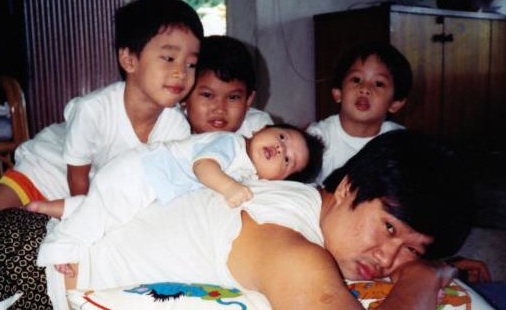Both are quite common abdominal wall defects afflicting neonates. Omphalocoele and gastrochisis were once thought to be the same entity until quite recently. Gastrochisis was once thought to be a ruptured omphalocoele. Now it is well known that this is not the case.
Other disease of abdominal wall defect includes cloacal exstrophy (epispadias), pentology of Cantrell and cordis extrophy but will not be covered in this article.
Definitions
Omphalocoele
This is a large defect in the anterior abdominal wall when amniotic membrane covers protruding midgut components which may include the liver, gonads and spleen.

Gastrochisis
This is usually a smaller defect with protrusion of midgut components
without membrane covering. The defect is usually to the right of the umbilicus.
In both defects, the
rectus abdominis muscles are intact.

Umbilical hernia differs from omphalocoele in the it is
covered by skin instead of amniotic membrane. It also usually appears not at birth but much later after.
Prevelance
Gastrochisis is more common than omphalocoele. Incidence is about 2 - 4.9 per 10000 live births.
Omphalocoele has an incidence of about 1 - 2.5 per 10000 live births.
Embryology
The body cavities are enclosed by folding of the embronic disc, anteriorly, caudally, and right and left laterally. This will leave the yolk sac in the middle. This occurs at
3 weeks of gestation.
At
5 weeks, the gut 'herniate' into the yolk sac and develop within.
At
10 weeks, the gut retracts back into the peritoneal cavity.
At least this is whats supposed to happen. When there's a failure of the lateral fold to complete, omphalocoele develops with failure of retraction of the midgut.
Gastrochisis supposedly occur due to failure of developement of the yolk sac. The gut has no space to expands and ruptures out of the abdominal wall. This usually occur on the right side of the umbilicus, probably due to weakness at that side due to involution of the right umbilical vein at 4 weeks of gestation.
Associated Anomalies
Omphalocoele
- Trisomy 18, 13, Triploidy, 45 X (Turner's)
- Aneuploidy
- Beckwith-Wiedemann syndrome
- Cardiac ~ 7 - 50%
- Central nervous system ~ 4 - 30%
- Musculoskeletal ~ 4 - 25%
- Genitourinary ~ 6 - 20%
- Gastrointestinal ~ 3 - 20% (Less compared to gastrochisis, probably due to protective effect of covering sac.
Gastrochisis
More associated with midgut anomalies
- Intestinal atresia ~ 7 - 30% (due to mesentric ischemia, likely due to compression by small abdominal defect)
- GERD ~ 16%
- Undescended testis ~ 15%
Antenatal Diagnosis
Sensitivity for detection with ultrasonography: 75% for omphalocoele, 83% for gastrochisis.
Omphalocoele
Centrally located, at base of umbilical cord insertion.
Presence of membrane.
Presence of liver (extracorporeal liver) carries poorer prognosis.
Associated with polyhydromnios (poorer prognosis)
Gastrochisis
Abdominal wall defect noted at right of umbilicus.
Variable amount of bowel protrusion.
Bowels usually thickened and edematous.
Assoicated with oligohydromnios
Associated with IUGR
Other anomalies should be sought out, especially for omphalocoeles.
Both have elevated serum and amniotic aFP and amniotic fluid acetylcholine (AChE) but more in gastrochisis (~80 more).
Amniocentesis may also help to rule out chromosomal abnormalities that may predict prognosis.
All above information combined may provide useful information to convey to parents and provide counseling as well as for discussion of prognosis.
Mode of Delivery
Controversial. No good RCT studies.
For gastrochisis, some reports less GIT complications with elective Caesarian section. Caesarian section recommended for large omphalocoele to prevent rupture of sac.
No benefit in earlier delivery unless if obstetrically indicated. Preterm delivery is associated with more complications associated with prematurity that may make management of the infant more difficult postnatally.
Termination of pregnancy should be considered and discussed with chromosomal abnormalities.
Delivery should ideally be done in a center with pediatric surgery expertise. Conditions of the bowels post-delivery is related to duration of time it takes between delivery and repair.
Management
Initial Care
- Keep NBM
- Keep warm
- Intestinal decompression with nasogastric tube and meconium evacuation
- Adequate hydration
- Prevent heat loss (especially important in gastrochisis where the bowels without sac are exposed, wrap with plastic or kitchen wrap).
- Respiratory support, ventilator readily available.
- Other anomalies excluded, especially cardiac lesions with omphalocoele.
Surgical Care

Omphalocoele
- The sac is cleaned with antiseptic.
- Attempt be made at manual reduction. May not succeed wholly at first. Incision around the defect is made and then the sac excised.
- Abdominal wall may be stretched posterior-to-anterior and bowel be replaced first followed by the liver to wedge the bowel in.
- The anterior abdominal wall is closed with sutures applied on all layers of the rectus including the muscle. After the closure is done without tying off the knot, an attempt is made to ventilate the patient. Closure is safe if patient is able to be ventilated with peak inspiratory pressure of less than cm H2O.
- If unable to reduce without closing the abdominal wall too tightly, a prosthetic silo is applied and the bowel reduced weekly.
- Any atresia or other bowel anomalies found may be operated 6 weeks after initial surgery.
Gastrochisis
- Similar principle to omphalocoele.
- Bowels are reduced and primary closure.
- While waiting, the bowel may be kept in a prosthetic silo. Some centers attempt to reduce bowel bedside.
Post-operative Care
- Continued ventilation.
- Continued hydration with urine output monitoring.
- Antibiotics.
- Bowel function may be delayed for up to 3 weeks. Any longer a contrast study may be indicated.
- Monitoring of complications related to respiratory difficulties. Sutures may need to be released and gradual reduction be made.
Complications
Short Term
- Associated anomalies (especially in omphalocoele).
- Associated with prematurity (especially in gastrochisis; hypoglycemia, respiratory distress syndrome, electrolyte imbalance, heat loss).
- Associated with tight closure causing respiratory distress.
Long Term
Small bowel obstruction.
*Absence of umbilicus (social distress).
Poor weight gain
Low IQ
Most of these complications vary in frequency depending on where the study is conducted.
References:
1.
Coran, Arnold G., et al., Pediatric Surgery, 7th Ed., Elsevier.
2. Hutson, John M., et al., Jones' Clinical Pediatric Surgery Diagnosis and Management, 6th ed., Blackwell Publishing (2008).
3. Nyberg, David A., et al., Diagnostic Imaging of Fetal Anomalies, Lippincott Williams & Wilkins, 2003.
Future Topics:
Surgical management
Bladder extrophy
Pentalogy of Cantrell
Cordis ectopia




